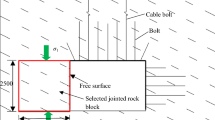Abstract
Geometrical parameters of discontinuities, such as spacing, length, dip and fault throw between joints have a great influence on the mechanical behavior of jointed rock masses. Accurate characterization for discontinuities is important for investigate the stability of rock masses. In this paper, the PFC2D is combined with joint network generation method to examine the mechanical behaviors of jointed mass. Taking Miaogou Open-pit Mine as an example, the information and statistical distributions of discontinuities of the slope rock masses are measured by ShapeMetriX3D measuring tool. Then, the automatic generation algorithm of random joints network based on the Monte-Carlo method is proposed using the programming language (FISH) embedded within PFC2D. This algorithm could represent the discontinuities compared with the geological surveys. In simulating the compression test of a jointed rock sample, the mechanical behavior and crack propagation were investigated. The results reveal that the failure mode and crack propagation of the jointed rock are dominated by the distribution of joints in addition to the intact rock properties. The simulation result shows the feasibility of the joints generating method in application to jointed rock mass.
Similar content being viewed by others
References
Pariseau W G, Puri S, Schmelter S C. A new model for effects of impersistent joint sets on rock slope stability. International Journal of Rock Mechanics and Mining Sciences, 2008, 45(2): 122–131
Cundall P A. A computer model for simulating progressive largescale movements in block systems. In: Proceedings of the Symposium of the International Society of Rock Mechanics. Rotterdam: A.A Balkema, 1971, 1: 8–12
Huang Y F, Feng J. Theory, Programs and Examples of Computing Engineering Geology. Beijing: Weapon Industry Press, 1992 (in Chinese)
Itasca Consulting Group, Inc. Particle Flow Code in 2-Dimensions: Command Reference version 3.1. Minneapolis, 2004
Austrian Startup Company. ShapeMetriX3D model merger user manual. Shenyang: Earth Products China Ltd, 2008
Yang T H, Yu Q L, Chen S K. Rock mass structure digital recognition and hydro-mechanical parameters characterization of sandstone in Fangezhuang coal mine. Chinese Journal of Rock Mechanics and Engineering, 2009, 28(12): 2482–2488 (in Chinese)
Shen H Y, Zhang P, Wang K. Improved linear congruential random number generators. Journal of Tsinghua University (Science & Technology), 2009, 49(2): 191–193
Su J M, Zhang L H, Liu B. Applications of MATLAB toolboxes. Beijing: Publishing House of Electronics Industry, 2004
Jiao Y Y, Zhang X L, Li T C. DDARF Method for Simulating the Whole Process of Rock Failure. Beijing: Science Publishing House, 2010
Bäckström A, Antikainen J, Backers T, Feng X, Jing L, Kobayashi A, Koyama T, Pan P, Rinne M, Shen B, Hudson J A. Numerical modelling of uniaxial compressive failure of granite with and without saline porewater. International Journal of Rock Mechanics and Mining Sciences, 2008, 45(7): 1126–1142
Potyondy D O. Simulating stress corrosion with a bonded-particle model for rock. International Journal of Rock Mechanics and Mining Sciences, 2007, 44(5): 677–691
Wang Y N, Fulvio T. Modeling Lac du Bonnet granite using a discrete element model. International Journal of Rock Mechanics and Mining Sciences, 2009, 46(7): 1124–1135
Hazzard J F, Young P P. Simulation acoustic emissions in bonded-particle models of rock. International Journal of Rock Mechanics and Mining Sciences, 2000, 37(5): 867–872
Itasca, Consulting Group Inc. Particle Flow Code in 2-Dimensions: FISH in PFC2D version 3.1. Minneapolis, 2004
Park J W, Song J J. Numerical simulation of a direct shear test on a rock joint using a bonded-particle model. International Journal of Rock Mechanics and Mining Sciences, 2009, 46(8): 1315–1328
Fu Z L. Experiment course on rock mechanics. Beijing: Chemical Industry Press, 2011 (in Chinese)
Hall S A, Muir Wood D, Ibraim E, Viggiani G. Localised deformation patterning in 2D granular materials revealed by digital image correlation. Granular Matter, 2010, 12(1): 1–14
Jiang Y J, Li B, Yosihiko T. Estimating the relation between surface roughness and mechanical properties of rock joints. International Journal of Rock Mechanics and Mining Sciences, 2006, 43(6): 837–846
Fardin N, Stephansson O, Jing L R. The scale dependence of rock joint surface roughness. International Journal of Rock Mechanics and Mining Sciences, 2001, 38(5): 659–669
Author information
Authors and Affiliations
Corresponding author
Rights and permissions
About this article
Cite this article
Wang, P., Yang, T., Yu, Q. et al. Characterization on jointed rock masses based on PFC2D. Front. Struct. Civ. Eng. 7, 32–38 (2013). https://doi.org/10.1007/s11709-013-0187-9
Received:
Accepted:
Published:
Issue Date:
DOI: https://doi.org/10.1007/s11709-013-0187-9




